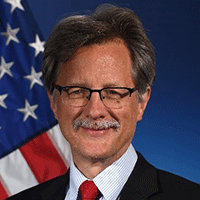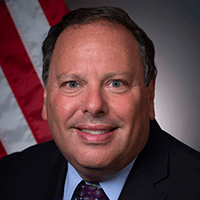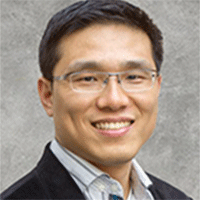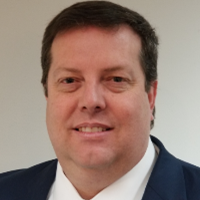October 25, 2022

Thomas E Kazior, PhD, IEEE Fellow, Program Manager, DARPA Microsystems Technology Office (MTO)
Presentation Title: Heterogeneous Integration (HI): An Enabler For Next Generation Systems
Abstract: To perform increasingly diverse missions in increasingly crowded EM environments, future sensor and communication systems will require increased bandwidth and sensitivity and enhanced functionality per unit area. These needs are driving sensor arrays towards higher levels of integration of a diverse set of materials, devices and components across multiple domains. This includes 3D solutions, particularly at millimeter wave and THz frequencies. This talk will present an overview of the evolution of heterogenous integration programs at DARPA and potential paths forward, including 3DHI at the transistor level being explored under the DARPA Heterogeneous Heterostructures (H2) and related programs.
Biography: Dr. Thomas E. Kazior joined DARPA in July 2020 as a program manager in the Microsystems Technology Office (MTO). His research interests include semiconductor material and device design, fabrication and integration processes including 3D heterogeneous integration (HI) of silicon and compound semiconductor and other non-silicon devices for RF arrays, and microwave/millimeter-wave/sub-millimeter-wave devices for sensors and communications.
Kazior received his Doctor of Philosophy degree in material science and engineering, specializing in electronic materials, from the Massachusetts Institute of Technology. Prior to joining DARPA, he was a senior principal fellow at Raytheon Company's Integrated Defense Systems. Kazior has co-authored more than 100 publications, contributed and invited conference papers, and a book chapter on compound semiconductor and heterogeneous integration technology. He also has more than 20 patents in semiconductor fabrication technology. Kazior participated in the International Technology Roadmap for Semiconductors (ITRS), co-authoring the analog mixed signal chapter. He is an IEEE fellow.

Ivor Barber, AMD
Presentation Title: Integration Strategies in the Chiplet Era
Ivor Barber is Corporate Vice President of Packaging at AMD developing advanced package solutions with Chiplet Architecture in High Performance Computing, Graphics and Visualization Technologies.
With over 40 years experience in the field of Semiconductor Packaging Ivor has held engineering and engineering management positions at National Semiconductor, Fairchild, VLSI Technology, LSI Logic and Xilinx. Ivor is a frequent panelist and presenter in packaging forums with deep experience in leading edge packaging solutions and high density interconnect technologies. Ivor has 20 published US patents in Semiconductor Package Manufacturing and Package Design and is a board member of MEPTEC. Ivor has a Bachelor of Science Degree in Manufacturing Technology from Napier University, Scotland, UK.
October 26, 2022

Mark S. Spector, Advanced Naval Platforms Division, Office of Naval Research
Presentation Title: Thermal Challenges for Future Military Platforms
Abstract: Modern land, sea, and air warfare technologies are trending towards significantly higher power loads with transient behavior that present unique challenges in thermal system design. Traditional design approaches assume steady state operation and rely on overdesign to meet worst-case scenarios. Moreover, advanced control techniques are virtually absent in most thermal systems. Therefore, tremendous opportunities exist to reduce the size, weight and power consumed by thermal management systems associated with these loads through the development of innovative components, the design of energy efficient system architectures, and their effective integration onto military platforms. This talk will discuss recent progress, as well as remaining research challenges, related to cooling of dynamic thermal loads.
Biography: Dr. Mark S. Spector is a Program Officer in the Advanced Naval Platforms Division at the Office of Naval Research where he manages programs in thermal science, metamaterials, and energy conversion. In addition, he sits on the Steering Committee of the Department of Defense Energy and Power Community of Interest and the NATO Applied Vehicle Technology Power and Propulsion Systems Technical Committee. Previously, he worked as a Research Physicist in the Center for Bio/Molecular Science and Engineering at the Naval Research Laboratory. He received his Ph.D. in Physics from the Massachusetts Institute of Technology and his A.B. in Physics and Applied Mathematics from University of California at Berkeley.

Dr. Philseok Kim, ARPA-E
Presentation Title: Pushing The Boundaries of Thermal Packaging for Enhanced Performance And Energy Efficiency
Abstract: With the advancement of cloud technologies and data centers, artificial intelligence, machine learning, and IoT-based data communications and operations, the power consumption of information and communication technology (ICT) has skyrocketed in recent years. Datacenters alone are estimated to consume 75 TWh/yr of electricity annually (approximately 2 percent of total US electricity consumption), and this consumption is expected to grow exponentially with exploding demand. However, the chip scaling efficiency (Moore's law) reached a tipping point in 2016, and conventional and incremental technological improvements to reduce electric power consumption have reached their limit, with the efficiency curve plateauing.
To make the next leap, transformative improvements in both performance and efficiency, as well as cost reductions, are required. Inefficiencies in complex, heterogenic integration of high powder density electronics result in inefficient power use and a large amount of waste heat, both of which must be managed for the reliable and efficient operation of ICT components and systems. Microscale thermomechanics and thermal management have become increasingly important as electronics have shrunk, but they are extremely difficult to understand and control due to the transient and spatially isolated nature of components or environments. Rather than dealing with thermal management in electronic devices as an afterthought, it is critical to employ a co-design approach early in the process to enable new designs. Quantum computing is rapidly approaching as a viable and unavoidable solution, with potential end use cases in a wide range of industries. However, for large-scale and cost-effective applications, better cooling solutions are critical. Transformational designs, materials, and manufacturing methods are needed, among other things, to reduce the cost and size of the associated cryogenics systems.
I will provide an overview of ARPA-E’s past and current program areas related to this problem, followed by a discussion of potential technology areas to push the boundaries of thermal materials and interfaces to enable the establishment of next generation electronics packaging.
Biography: Dr. Philseok Kim is a program director at ARPA-E with a focus on functional materials and composites, engineered surfaces and structures that enable and accelerate electrification and decarbonization of energy infrastructure with high energy-efficiency, resilience, and low carbon emissions. Prior to joining ARPA-E, Dr. Kim co-founded Adaptive Surface Technologies, Inc. leveraging ARPA-E-funded SLIPS projects and launching commercial products such as fouling-resistant and fuel-saving ship hull coatings. He also co-led SLIPS project at Harvard University to improve the energy efficiency of refrigerators by reducing frost formation and defrost time. Dr. Kim has 12 years of experience in petrochemicals, polymers, and coatings industry. Raised in South Korea, Dr. Kim received his B.S. and M.S. from Seoul National University then Ph.D. in chemistry at Georgia Institute of Technology. Dr. Kim has published over 40 papers in high-impact, peer-reviewed journals and holds about 40 issued patents in surface functionalization, materials for organic field-effect transistors, adaptive optical materials, and slippery surfaces.
October 27, 2022

Abhinav Saxena, GE Research, USA
Presentation Title: Use of AI and ML in Improving Industrial Reliability towards Achieving Operational Autonomy – Successes and Challenges
Abstract: Predictive Maintenance (PM) is becoming ubiquitous for improving availability and reliability along with reducing O&M costs in industrial systems. Despite significant research and development investment in the last decade most deployed solutions still tend to be piecemeal (component or failure mode specific) point solutions and generally lack trust with respect to automated decision making. Full end-to-end deployment with system-wide coverage and autonomy still remains an elusive goal in industrial setting. This is primarily due to high cost and limited scalability of conventional modeling approaches for underlying complex systems and processes in large fleets. Specifically, capabilities to safe-guard against unknown-unknowns, lack of explainability and trust tend to be key bottlenecks. Given these systems are heavily instrumented generating large volumes of high-speed data and compute costs continue to go down, recent advancements in data-driven methods using machine learning (ML) and artificial intelligence (AI) have shown promise in a number of areas that previously led to valley of death between PM technology and commercialization. GE’s Digital Twin technology for Predictive Maintenance is leveraging AI to bridge a number of such critical gaps that were otherwise very challenging to tackle through conventional methods. This session will enumerate key challenges in enabling system-wide predictive maintenance and how AI is being used to overcome these. Specifically, a causal deep learning-based approach will be described that provides a causal graph of inter-variable relationships allowing validation of deep learning model with domain experts. Further, by providing causal factors for identified anomalies root cause analysis can be facilitated for alert disposition in efficient manner at the fleet level. We will also describe our approach towards competency awareness of AI models, which aims to solve uncertainty management and trust for industrial applications of AI. Various applications and use-cases will be shared to show effectiveness of AI and ML using both structured and unstructured data in the context of intelligent PM.

John D. Williams, Boeing
Presentation Title: Multilayer Flexible Electronic Devices for IoT and RF Applications
Abstract: Boeing is actively engaged in the development of Flexible Hybrid Electronics. Our team prototypes various antennas, IoT devices, radar boards, and low cost conformal phased arrays. We began with single layer processes and have expanded rapidly prototype development of multilayer flexible printed circuit boards (Flex-PCBs) for size weight power and cost saving applications. Flex PCBs allow electronics to be wrapped onto cylindrical or bi-axial curved surfaces. Conventional Flex PCBs contain either one to six copper layers with limited electronic packaging. Most devices are bonded to rigid boards that contain complex packaged electronics. Boeing's processes, however, apply copper clad or printed inks on polyimide substrates to build fully functional flex-PCBs between two and eight conductive layers thick. Thus allowing antennas, sensors, communication links, and radars to be placed directly onto the surface of a vehicle. Similarly, power routing, and microcontrollers can conform to surfaces or interior cavities. This technology represents a transformative approach to PCBs in aerospace applications.
Our team has demonstrated this capability on RF boards with no less than 500 through vias, 100 buried vias, and 50 electronically packaged components. Complex boards can be turned in days without electroplating. Pyralux AP polyimide substrates from DuPont, Taconic, and 3M bonding adhesive achieves alignment errors of 2 mil or less over an 8 x 10 square inch area. Kapton substrates have been used with ink jet printing of particle free silver and UV curable dielectrics to create three layer IoT devices. Vias are filled using conductive inks. Electronic packaging is currently performed using anisotropic conductive epoxy, silver ink, or low temperature solder. Cost models have been completed for printed silver devices, documenting the manufacturability from Manufacturing Readiness Levels (MRL) 4 to 6. We are currently examining pilot capability of different suppliers to manufacture devices at volumes needed for commercial activities.
Biography: Dr. John D. Williams received his PhD in Engineering Science from LSU in 2004 and became a NextFlex Fellow in 2019 and a Boeing Technical Fellow in 2022. John has 17 years of Principal Investigator experience in device fabrication and is currently the principal investigator on numerous NextFlex contracts focused on antenna arrays and multilayer printing on curved surfaces. John is currently developing Additive Electronics Technologies (AET) for use on Boeing platforms. From 2004 to 2014 he served as a Senior Member of the Technical Staff at Sandia National Laboratories, and as an Assistant Professor of Electrical, Optical and Material Engineering at the University of Alabama in Huntsville (UAH). He joined Boeing in 2014 to found the Boeing Research and Technology AET effort in Huntsville where his team performs novel research in microwave filters, antennas, and flexible hybrid electronic (FHE) sensors by maturing manufacturing capabilities, implementing modeling and simulation, and developing prototype demonstrators.
John is the principal / co-principal investigator for 4 concurrent NextFlex MII Projects. He has led, or co-led, 7 other NextFlex projects, serves on the NextFlex Technical Council, and is an industry co-lead for the NextFlex Materials Technical Working Group. He also serves as an industrial committee member for the ManTech JDMTP Electronics Subpanel. In 2021 he served on the organizing committee for the IEEE International Flexible Electronics Technologies Conference (IFETC). John has published more than 30 peer reviewed articles, over 30 US patents, 17 international patents, 4 Boeing trade secrets, and dozens of pending patents. John’s Boeing related inventions on microwave filters, conformal antennas, hyperspectral metrology, and cryogenic cooling of MW class EMI filters are currently being developed for multiple program efforts.